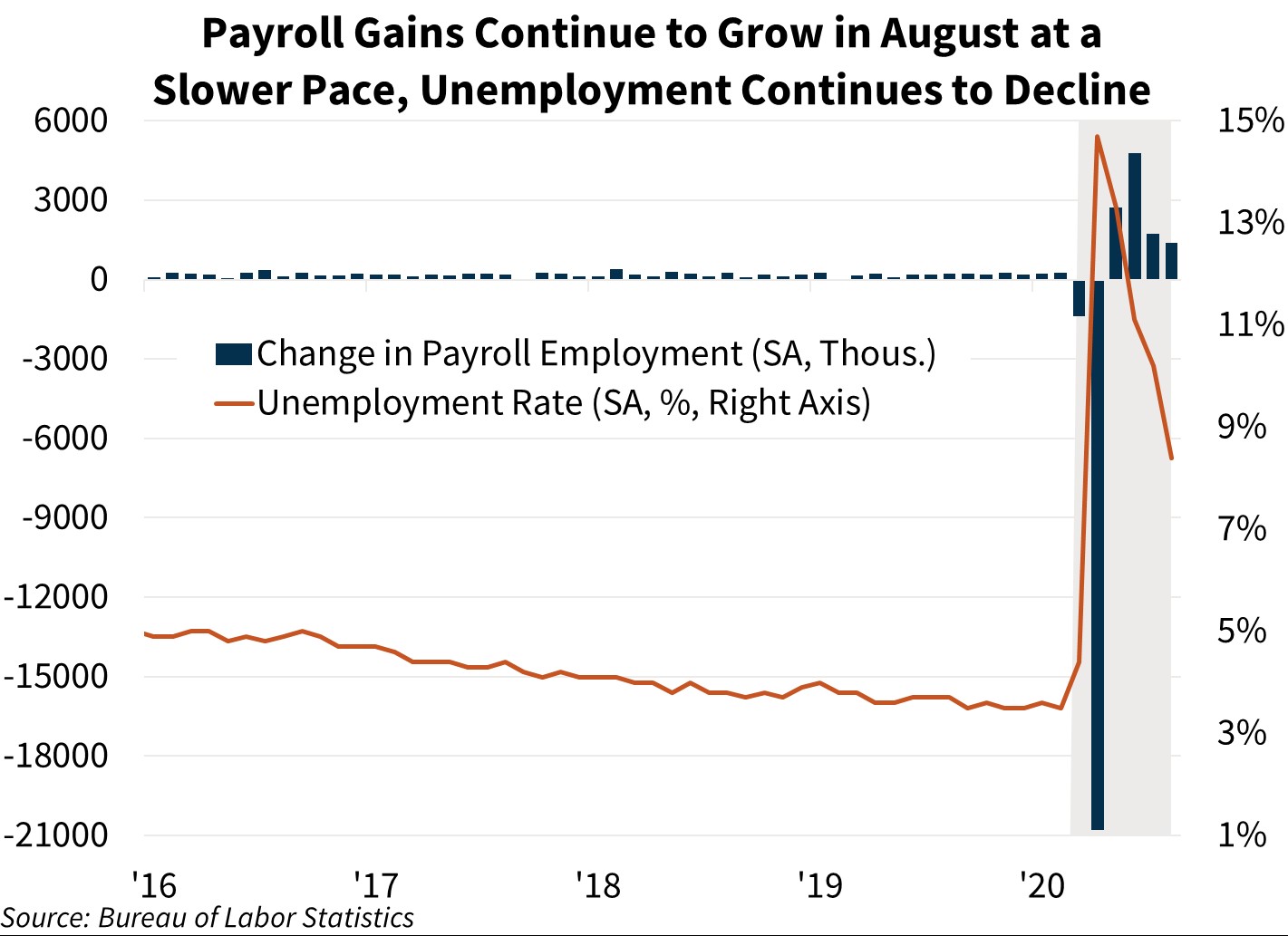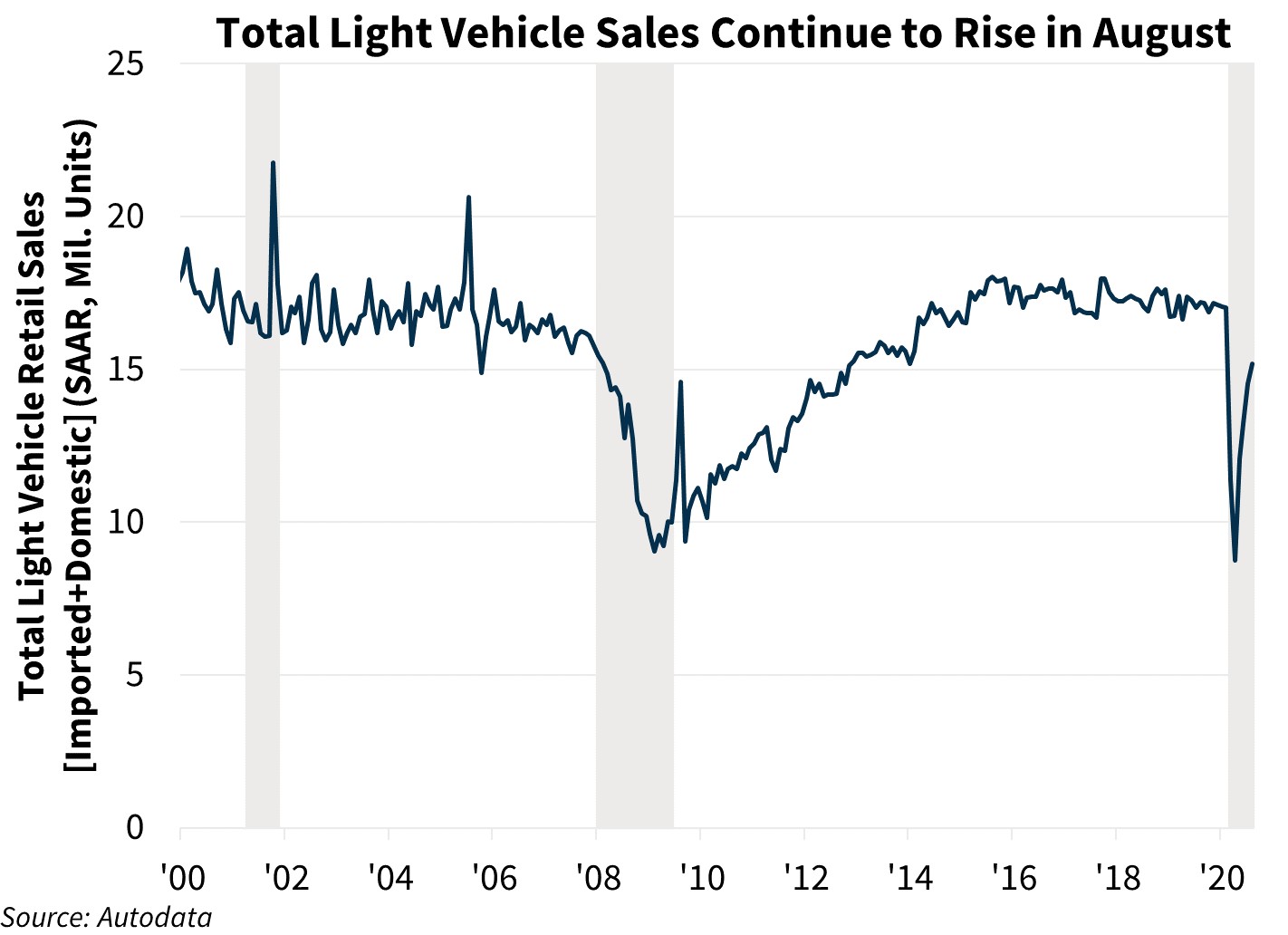Manufacturing and Service Sector Activity Continue to Expand
Key Takeaways:
- Nonfarm payrolls increased by 1.4 million in August, according to the Bureau of Labor Statistics, a deceleration from last month’s pace. The bulk of private sector hiring came from service industries, with robust jobs gains in retail trade and leisure and hospitality sectors. Residential construction employment (including specialty trade contractors) grew by 27,700. The number of persons working part-time but who would prefer full-time employment continued to decline, falling 871,000. The unemployment rate fell by 1.8 percentage points to 8.4 percent, doubling the decline from last month.
- Factory orders and shipments rose 6.4 percent and 4.6 percent in July, respectively. Nondurable goods orders increased 1.8 percent, though they remain well below early-2020 levels. Core capital goods orders and shipments held on to the gains registered in the advanced durable goods report.
- Light vehicle sales increased 4.5 percent in August to a seasonally adjusted annualized rate (SAAR) of 15.2 million units, according to Autodata. From a year ago, sales fell 11.7 percent, the sixth consecutive month of annual declines.
- The ISM Manufacturing Index, a measure of manufacturing activity, posted the fourth straight month of gains in August, increasing another 1.8 points to 56.0, the highest level since November 2018. After remaining in contraction territory from March to May, the index is now solidly back in expansion territory. The ISM Services Index, a gauge of service-sector activity, remained in expansion territory in August at 56.9 (any reading above 50 indicates expansion), but decelerated 1.2 points from July.
- Nonfarm business productivity rose 10.1 percent annualized in Q2 2020, according to the revised estimate by the Bureau of Labor Statistics, 2.8 percentage points higher than the preliminary estimate. This is the largest annualized increase since Q1 1971. Total hours worked fell by a record 42.9 percent annualized, essentially unchanged from the preliminary estimate, while real output declined by a record 37.1 percent annualized (1.8 percentage points higher than the original decline). Unit labor costs increased 9.0 percent annualized, 3.2 percentage points lower than previously estimated.
- According to the Census Bureau, the real goods trade deficit (an input into the calculation of net exports) widened by approximately $10.1 billion to $90.5 billion in July. This was the largest monthly deficit in over five years and pushed the real trade deficit close to the record level set at the end of 2018. Exports and imports jumped 10.8 percent and 11.5 percent, respectively, the latter representing the largest one-month increase in imports since the series began in 1994.
- Private residential construction spending increased 2.1 percent in July according to the Census Bureau, the first increase since February. New single-family construction spending rose 3.1 percent and new multifamily construction spending rose 4.9 percent. From a year ago, new single-family spending fell 4.3 percent, while multifamily spending rose 6.2 percent.
Forecast Impact:
The August jobs report gave some mixed signals on the ongoing labor market recovery. While payroll employment growth has averaged 2.7 million per month since April’s trough, total nonfarm employment is still 7.6 percent below February’s peak, reflecting the dramatic and sudden depth of this recession. Meanwhile, the household survey painted a rosier picture of the labor market, suggesting there were close to 3.8 million additional employed persons in August; however, the household survey tends to be more volatile, given its significantly smaller sample size. Light vehicle sales, one of the earliest indicators of consumer spending, posted a solid gain in August, albeit decelerating from the prior months, and continued to support our expectations of a strong rebound in consumer spending in the third quarter. While Q2 nonfarm business productivity was revised upwards, the underlying details still showed a sharp decline in both total hours worked and total output, though we believe this relationship will likely return to a more “normal” level as the labor market continues to recover through the third quarter. The manufacturing sector started the third quarter on a positive note as factory orders and shipments both increased in July. The trend likely continued as measures of activity in the manufacturing and service sectors expanded in August, with the measures of activity now surpassing or near early-2020 levels. We continue to believe that nonresidential fixed investment will turn positive in the third quarter, which would be the first positive quarter in a year. Housing data continue to come in strong and the increase in construction spending in July supports our expectation for a sharp rebound in residential investment in the third quarter.


Economic and Strategic Research Group
September 4, 2020
Opinions, analyses, estimates, forecasts and other views of Fannie Mae's Economic and Strategic Research (ESR) Group included in these materials should not be construed as indicating Fannie Mae's business prospects or expected results, are based on a number of assumptions, and are subject to change without notice. How this information affects Fannie Mae will depend on many factors. Although the ESR group bases its opinions, analyses, estimates, forecasts and other views on information it considers reliable, it does not guarantee that the information provided in these materials is accurate, current or suitable for any particular purpose. Changes in the assumptions or the information underlying these views, including assumptions about the duration and magnitude of shutdowns and social distancing, could produce materially different results. The analyses, opinions, estimates, forecasts and other views published by the ESR group represent the views of that group as of the date indicated and do not necessarily represent the views of Fannie Mae or its management.
